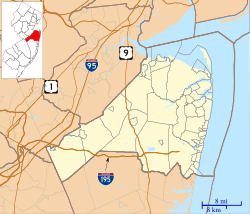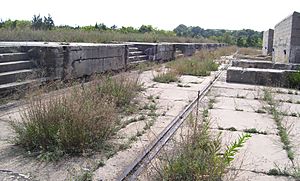Sandy Hook Proving Ground facts for kids
Quick facts for kids Sandy Hook Proving Ground |
|
|---|---|
| United States | |
| Sandy Hook Near Atlantic Highlands, New Jersey in United States |
|

Entrance (1911)
|
|
|
Location of the Proving Ground on Sandy Hook
|
|
| Coordinates | 40°28′2.852″N 73°59′57.203″W / 40.46745889°N 73.99922306°W |
| Type | Proving ground |
| Site information | |
| Owner | United States Department of War |
| Operator | |
| Controlled by | U.S. Ordnance Department |
| Open to the public |
Yes, with restrictions |
| Condition | Poor |
| Adjoining facility | Fort Hancock |
| Site history | |
| Built | August 7, 1874 |
| Built by | |
| In use | 1876-1919 |
| Fate | Facilities relocated; buildings abandoned |
| Test information | |
| Other tests | Artillery |
| Remediation | None |
|
Fort Hancock and the Sandy Hook Proving Ground Historic District
|
|
|
U.S. Historic district
Contributing property |
|
| Visitation | 6,021,713 (2014) |
| Part of | Fort Hancock and the Sandy Hook Proving Ground Historic District (ID80002505) |
| Significant dates | |
| Designated NHL | December 17, 1982 |
| Designated CP | April 24, 1980 |
The Sandy Hook Proving Ground was a special military place in New Jersey, right by the Atlantic Ocean. It was set up on August 7, 1874. Its main job was to be the first place where the United States Army could test new weapons and military gear.
It was located on Sandy Hook, a long, thin piece of land that sticks out into the ocean. This land was about 6 miles long and half a mile wide. The Proving Ground worked closely with Fort Hancock, a nearby army fort. The site was mostly closed down in 1919. Today, many of its old buildings are still there, but they are falling apart. The National Park Service now owns the area. Most parts are not open to the public.
Contents
Why Sandy Hook Was Chosen
The American Civil War, which ended just ten years before, brought many new types of weapons. Rifled cannons could shoot pointed bullets farther and faster than old cannonballs. Ironclad warships had powerful guns that could destroy fort walls. The Army needed a place to test these new weapons safely.
Sandy Hook was perfect for testing heavy guns. The land was already owned by the government. It had flat, open areas needed for tests. Sandy Hook was also far enough from towns to be safe. But it was still close to big cities and could be reached by water. In 1874, much of Sandy Hook was covered with forests and marshes. These natural areas still cover a lot of the land today.
Most of the Army's buildings were at the northern end of Sandy Hook. A huge granite fort was there, but it was never fully finished. There was also a dock built in 1857. This dock helped with the fort's construction. A life-saving station was also on the northeastern shore. The Proving Ground was built on the eastern side of Sandy Hook. It was just below the fort. The firing range stretched south along the beach. It had wooden gun platforms, a safe shelter, and sand piles to stop bullets.
Testing New Weapons
After the Proving Ground was officially started in 1874, it took almost two years to get everything ready. Once it was ready, many new weapons were tested there. These included guns and equipment for defending the coast. Over time, several brick buildings were added. These included maintenance buildings and an Officers Club. When Fort Hancock became an active army post in 1895, it shared Sandy Hook with the Proving Ground.
The Proof Battery
The "Proof Battery" was where new and changed guns were fired. It was built on the northeastern end of Sandy Hook, facing the ocean. The firing range went 3,000 yards south along the beach. For very long shots, guns were aimed out to sea.
The first test firing happened in October 1874. An old 10-inch Rodman cannon was changed into an 8-inch rifled gun. It fired 700 times. The Army found the gun was still strong and working well.
To see how powerful the guns were, armor-piercing bullets were fired at thick iron plates. These plates were like the ones used on warships. The tests showed that rifled Rodman guns could break through armor. But they could only do it at short distances. In the 1880s, new, powerful steel cannons were made. These guns loaded from the back and had longer ranges. They also had more striking power.
When new guns and mortars passed their tests, they were made in factories. Then they were sent to Sandy Hook for final testing. Many new types of gunpowder, artillery shells, and fuses were also tested there.
In 1900, the Proof Battery moved. Fort Hancock needed the old spot for a new gun battery. The new battery was built southeast of the old one. The eastern end of the new Proof Battery was for testing machine guns and smaller field guns. Larger guns, like 14-inch cannons, were tested at the west end. In the middle, many different guns from 1 to 12 inches were set up. When a gun was fired, the crew stood behind 12-foot thick concrete walls. This kept them safe if the gun exploded. People could also watch from a 50-foot observation tower.
The Base Railroad
In 1889, a narrow railroad was built. It helped bring equipment and guns from the docks to the Proof Battery. In 1893, a standard railroad was finished. This connected Sandy Hook to other commercial train lines. These lines were first built for tourists coming from New York City by steamship. The train would take them to places like Long Branch.
Later, Fort Hancock did not want civilians near its buildings. So, the civilian railroad was moved. Eventually, it was removed completely. The Sandy Hook Proving Ground then took over the railroad on the Hook. They used it for soldiers, supplies, and moving railway guns. This also allowed them to connect with major railroads in Highlands, New Jersey. The Proving Ground's train engine was named "General Rodman." When the Proving Ground left around 1920, the railroad was given to Fort Hancock.
The Final Years
Sandy Hook Proving Ground became a permanent military base in 1903. It continued to test weapons through World War I. During the war, Colden Ruggles was in charge of the site. He later became the Army's Chief of Ordnance.
Sandy Hook Proving Ground and Fort Hancock worked together. The Proving Ground tested weapons. Fort Hancock protected New York Harbor. However, guns could shoot farther and farther away. Sandy Hook did not have enough space to test these new long-range guns. In 1919, testing was moved to a bigger place. This new place was the Aberdeen Proving Ground in Aberdeen, Maryland.
Images for kids







